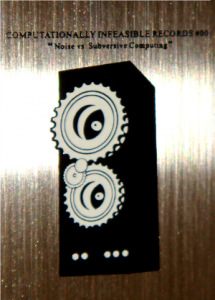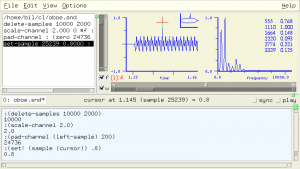The Art of Noise
This post is on different subject than the topics covered usually, it describes my entry to the Noise vs. Subversive Computing compilation.
A couple of months ago Pascal Cretain invited me to participate in a very interesting project. A bunch of security people and a bunch of noise artists were going to collaborate, the mission was : The Noisicians will have "Subversive Computing" as their central theme, and the Subversive Technologists will work with "Noise".

This may not sound very complex, but it is! Despite what we use noise for and what our perception of noise is, it is not easy to generate, compose and generally conceive it in a controlled and meaningful way. Cacophony or atonality can very quickly displease, due to the surprise element which is usually generated by abnormal db fluctuations.
Having all these in mind, I start thinking of a way to create a natural sound (around noise) which will assist in creating a visually familiar image, without surprising the listener too much.
The idea that popped into my mind was to generate an audible version of a Rainbow. To do that I chose to use what it is known as the "Colors of Noise", which refers to the power distribution in frequency spectrum of different types of noise.
If you think that it is easy to create different types of noise, then I have to assume that you haven't tried. For my experiments I used the tools included in the CCRMA, and more specifically CLM (Common Lisp Music) and SND (Sound editor).

I also used several of the example scripts that come with these packages and in cases that I couldn't create a specific "colour", I used a bit of artistic license and normal mixing (subtractive and additive) e.g. yellow + red = orange.
Example script to generate Green Noise (bounded brownian noise) :
(definstrument (green3 start dur freq amp amp-env noise-freq noise-width noise-max-step)
(let* ((grn (make-green-noise-interp :frequency noise-freq
:amplitude noise-max-step
:high (* 0.5 noise-width) :low (* -0.5 noise-width)))
(osc (make-oscil freq))
(e (make-env amp-env :scaler amp :duration dur))
(beg (seconds->samples start))
(end (+ beg (seconds->samples dur))))
(run
(lambda ()
(do ((i beg (+ 1 i)))
((= i end))
(outa i (* (env e)
(+ 1.0 (green-noise-interp grn))
(oscil osc))))))))
(with-sound ()
(green3 0 2.0 440 .5 '(0 0 1 1 2 1 3 0) 100 .2 .02))
Finally, all colours mix with the prior colour/s right after they introduce themselves.
Something like : Colours[0], Colours[1], Colours[0]+Colours[1], Colours[2], .........
On the foreground , there is a minimalistic piano composition which tries to not distract too much from the background colours and helps in assisting the after rain "Rainbow" effect.

For more information about the project, the participants and their very interesting ideas,
visit : http://www.myspace.com/pascalcretain
The compilation has been released with
Computationally Infeasible Records